Fertilization in plants is a cornerstone of plant reproduction, enabling the continuation of species and the production of seeds that give rise to new plants. This intricate process involves the fusion of male and female gametes to form a zygote, which subsequently develops into an embryo. Discovered by Eduard Strasburger in 1884, fertilization in plants, particularly in angiosperms (flowering plants), is a fascinating sequence of events that includes pollination, germination, and the unique phenomenon of double fertilization.
In this extensive article, we will explore the mechanisms, types, and significance of fertilization in plants, delving into the reproductive structures, processes, and post-fertilization developments that make this biological event so remarkable.
Table of Contents
What is Fertilization in Plants?
Fertilization is the process by which a male gamete, carried by pollen, unites with a female gamete in the ovule to form a diploid zygote. In angiosperms, this occurs within the embryo sac, a structure housed in the ovule. The journey of the male gamete begins when pollen grains land on the stigma of a flower. From there, a pollen tube forms, acting as a conduit to transport the male gametes deep into the ovule. This process ensures that fertilization occurs efficiently, even in the complex architecture of a flower’s reproductive organs. The discovery of fertilization by Strasburger marked a significant milestone in plant biology, shedding light on how plants reproduce sexually to produce viable offspring.
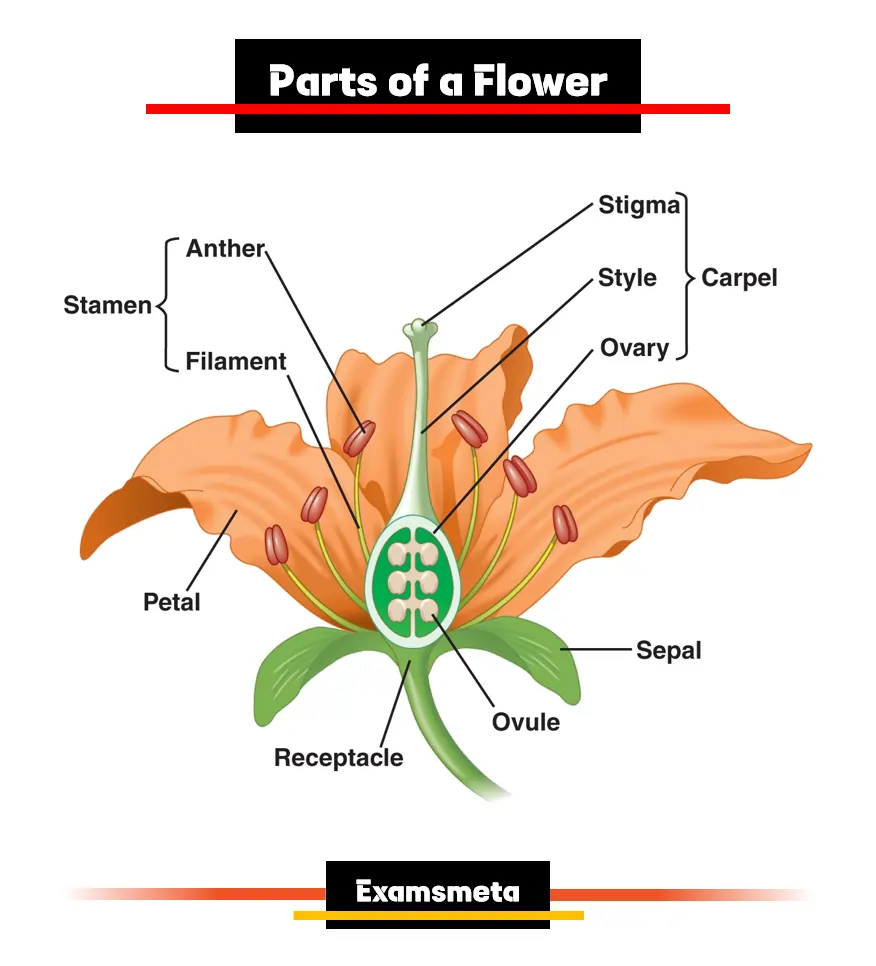
Reproductive Parts of the Plant
The flower serves as the primary reproductive organ in angiosperms, housing both male and female reproductive structures. These structures work in tandem to facilitate fertilization.
Male Reproductive Part: Androecium
The androecium is the male reproductive component of the flower, consisting of stamens. Each stamen is composed of:
- Anther: A bilobed structure that produces and stores pollen grains, which contain the male gametophytes.
- Filament: A slender stalk that supports the anther, positioning it for effective pollen dispersal.
The pollen grains are critical, as they carry the genetic material necessary for fertilization. Each pollen grain contains two nuclei: a tube nucleus, which guides the pollen tube’s growth, and a generative nucleus, which divides to produce two male gametes.
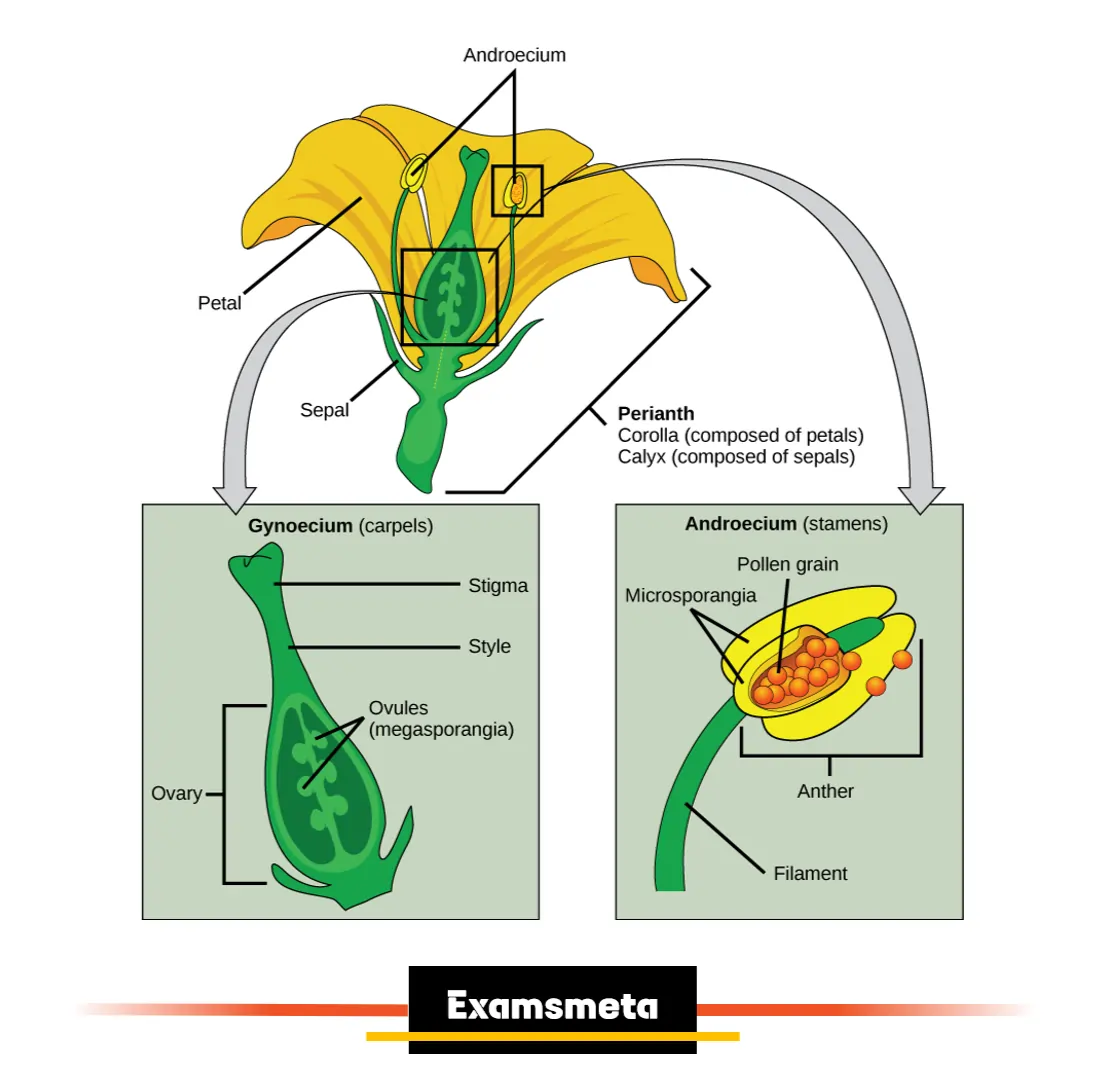
Female Reproductive Part: Gynoecium
The gynoecium, or pistil, is the female reproductive organ. It comprises three key components:
- Stigma: The sticky surface that captures pollen grains.
- Style: A slender tube that connects the stigma to the ovary, providing a pathway for the pollen tube.
- Ovary: The enlarged basal portion that contains one or more ovules, each housing a female gametophyte (embryo sac).
The ovules are the sites of fertilization, where the female gametophyte awaits the arrival of male gametes. The embryo sac typically contains an egg cell, two polar nuclei, and other supporting cells like synergids and antipodal cells.
The Process of Fertilization
Fertilization in plants is a multi-step process that begins with the transfer of pollen and culminates in the fusion of gametes. Below, we outline the key stages involved:

Pollination
Pollination is the transfer of pollen grains from the anther of one flower to the stigma of another (or the same) flower. This process can occur through various agents, including:
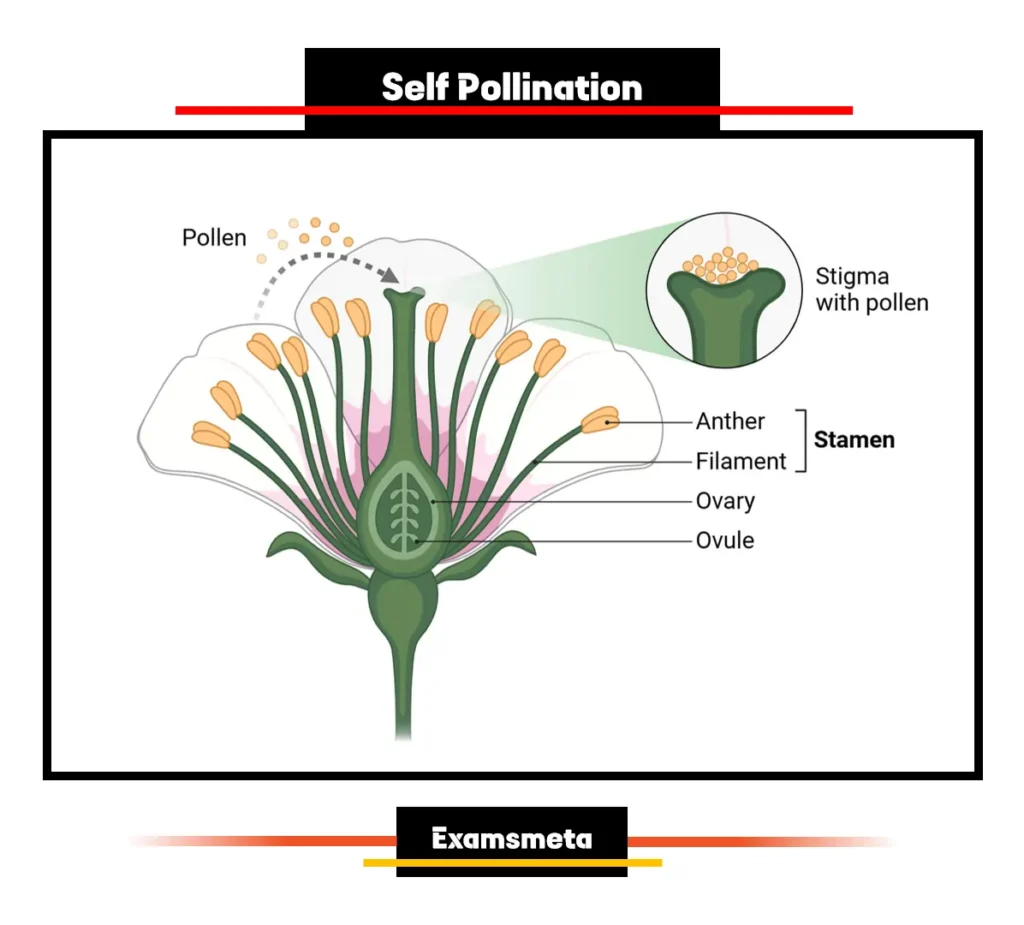
- Wind: Common in grasses and conifers, where lightweight pollen is carried by air currents.
- Water: Seen in aquatic plants like Vallisneria, where pollen floats to reach the stigma.
- Animals: Insects (e.g., bees, butterflies), birds, and bats are frequent pollinators, attracted by nectar or vibrant flower colors.

Pollination sets the stage for fertilization by ensuring that pollen reaches the stigma, where it can begin the next phase of the reproductive process.
Germination of Pollen
Once pollen lands on a compatible stigma, it undergoes germination. The pollen grain absorbs moisture and nutrients from the stigma, triggering the formation of a pollen tube. This tube grows downward through the style, guided by the tube nucleus. Meanwhile, the generative nucleus within the pollen grain divides mitotically to produce two male gametes. The pollen tube’s growth is a remarkable feat, as it navigates through the stigmatic tissue and style to reach the ovary, deriving nourishment from the surrounding tissues.
Fertilization
Fertilization proper begins when the pollen tube reaches the ovule. The tube penetrates the ovule, typically through the micropyle, and releases the two male gametes into the embryo sac. One gamete fuses with the egg cell in a process called syngamy, forming a diploid zygote. The second gamete fuses with the two polar nuclei in the central cell, forming a triploid primary endosperm nucleus. This dual fusion event, known as double fertilization, is a hallmark of angiosperms and ensures the coordinated development of the embryo and its food supply.
Types of Fertilization
The entry of the pollen tube into the ovule can occur in three distinct ways, each with a specific name based on the point of entry. These types are:
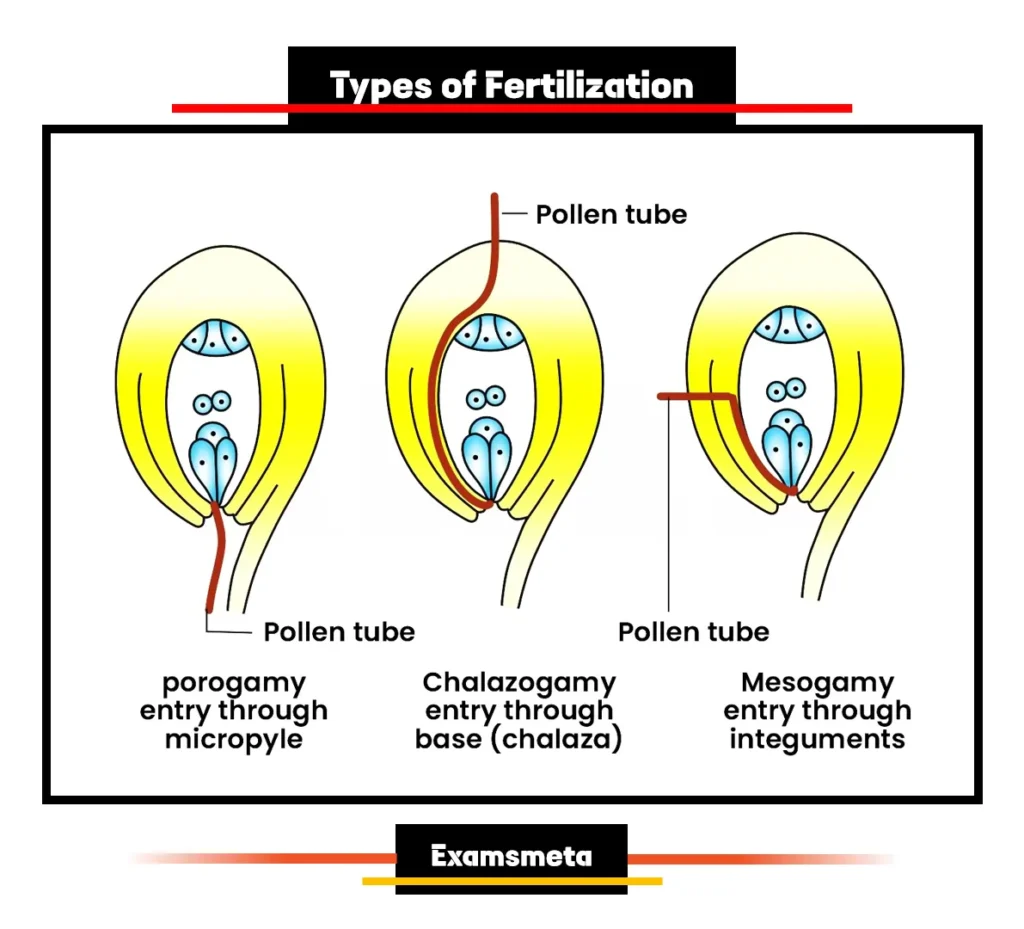
Porogamy
Porogamy is the most common mode of pollen tube entry, where the tube penetrates the ovule through the micropyle. This pathway is efficient and widely observed in angiosperms, ensuring precise delivery of male gametes to the embryo sac.
Chalazogamy
In chalazogamy, the pollen tube enters the ovule through the chalaza, the basal part opposite the micropyle. This mode is less common and is observed in plants like Casuarina, Betula, and Juglans regia. Chalazogamy represents an alternative strategy for gamete delivery, adapted to the specific anatomy of certain plants.
Mesogamy
Mesogamy occurs when the pollen tube enters the ovule through the integument (the protective layers surrounding the ovule) or the funicle (the stalk connecting the ovule to the ovary). Examples include Cucurbita (via integument) and Pistacia (via funicle). Mesogamy is relatively rare but highlights the diversity of fertilization mechanisms in plants.
Double Fertilization: A Unique Feature
Double fertilization, first described by S.G. Nawaschin in 1898, is a defining characteristic of angiosperms. This process involves two separate fusion events within the embryo sac:
- Syngamy: One male gamete fuses with the egg cell, forming a diploid zygote. This zygote develops into the embryo, the precursor to the new plant.
- Triple Fusion: The second male gamete fuses with the two polar nuclei in the central cell, forming a triploid primary endosperm nucleus. This nucleus gives rise to the endosperm, a nutrient-rich tissue that nourishes the developing embryo.
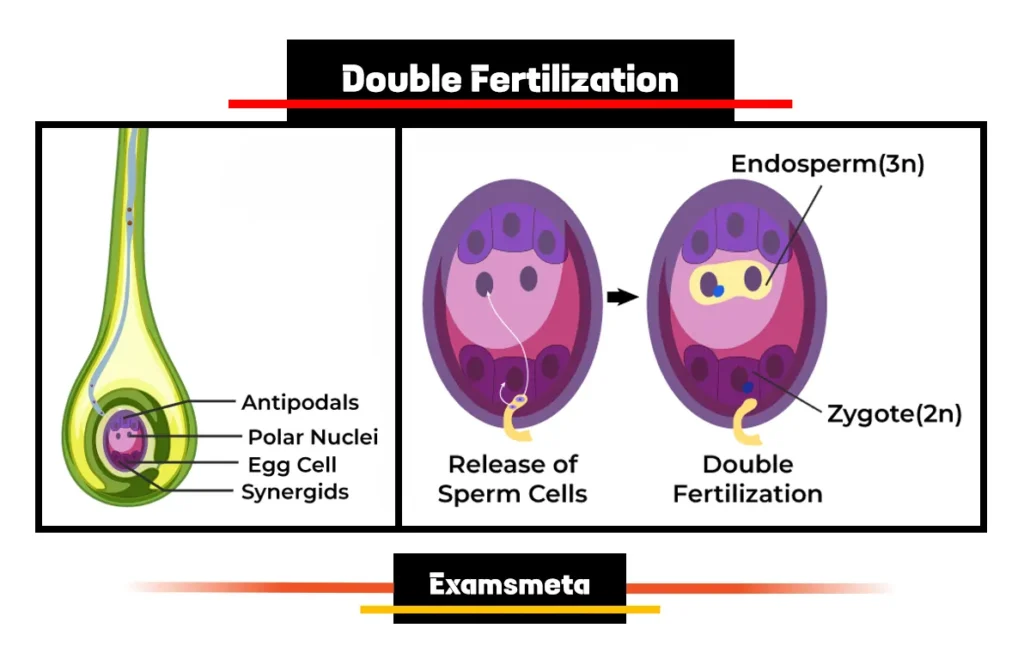
The term “double fertilization” reflects the occurrence of both syngamy and triple fusion. The endosperm plays a critical role in seed development, providing energy for the embryo until it can perform photosynthesis. This dual fertilization strategy enhances reproductive efficiency by ensuring that resources are allocated only to fertilized ovules.
Post-Fertilization Development
After fertilization, the embryo sac undergoes significant changes to support the growth of the next generation. The key developments include:
Embryo Development
The zygote divides and differentiates to form the embryo, which consists of a plumule (future shoot), a radicle (future root), and cotyledons (seed leaves). The embryo is the blueprint for the new plant, containing all the genetic information needed for growth.
Endosperm Development
The primary endosperm nucleus divides to form the endosperm, a triploid tissue that serves as a food reserve. In some plants (e.g., cereals), the endosperm persists in the mature seed, while in others (e.g., beans), it is absorbed by the cotyledons during development.
Degeneration of Other Cells
The synergids and antipodal cells in the embryo sac, which play supporting roles during fertilization, degenerate after the process is complete. This ensures that resources are directed toward the developing embryo and endosperm.
Seed and Fruit Formation
The ovule develops into a seed, with the embryo and endosperm encased in a protective seed coat. The ovary transforms into a fruit, which aids in seed dispersal. These structures are critical for the survival and dissemination of the next generation.
Importance of Fertilization
Fertilization is a pivotal process in plant reproduction, with far-reaching implications for plant survival and diversity. The following points highlight its significance:
- Ensures Resource Allocation: Double fertilization ensures that the parent plant invests in endosperm formation only when the egg is fertilized, optimizing resource use.
- Forms the Embryo: The zygote resulting from fertilization develops into an embryo, which grows into a new plant, perpetuating the species.
- Restores Diploidy: Fertilization combines haploid male and female gametes to produce a diploid zygote, maintaining the plant’s genetic stability.
- Prevents Polyembryony: By ensuring a single fertilization event per ovule, fertilization minimizes the occurrence of polyembryony (multiple embryos in one seed), which could lead to competition for resources.
Examples of Fertilization in Plants
To illustrate the diversity of fertilization mechanisms, consider the following examples:
- Maize (Zea mays): A wind-pollinated plant that relies on porogamy for pollen tube entry. Its large endosperm makes it a staple food crop.
- Casuarina: A tree species that uses chalazogamy, showcasing an alternative fertilization strategy.
- Cucurbita (Pumpkin): Employs mesogamy via the integument, highlighting the adaptability of fertilization mechanisms.
- Orchids: These plants often rely on insect pollination, with precise pollen tube growth ensuring successful fertilization in their complex flowers.
Conclusion
Fertilization in plants is a remarkable process that underscores the complexity and efficiency of plant reproduction. From the initial act of pollination to the intricate events of double fertilization, each step is finely tuned to ensure the successful production of seeds. The diversity of fertilization types—porogamy, chalazogamy, and mesogamy—reflects the adaptability of plants to their environments. Moreover, the formation of the embryo and endosperm through fertilization secures the survival of the next generation, making this process a cornerstone of plant biology. By understanding fertilization, we gain insight into the mechanisms that sustain plant life and support global ecosystems.
Acknowledgements
The development of the article “Fertilization in Plants: A Comprehensive Guide” was made possible through the wealth of information provided by several reputable online resources. These sources offered detailed insights into plant reproduction, fertilization mechanisms, and related processes, ensuring the article’s accuracy and depth.
The Examsmeta expresses its gratitude to the following websites for their valuable contributions:
- Britannica: For providing foundational knowledge on plant reproductive processes and terminology.
- Nature: For offering in-depth scientific articles on double fertilization and its significance in angiosperms.
- ScienceDirect: For supplying peer-reviewed studies on pollen tube growth and fertilization mechanisms.
- Khan Academy: For clear explanations of pollination and plant reproductive structures, enhancing the article’s accessibility.
- Biology Online: For detailed descriptions of porogamy, chalazogamy, and mesogamy.
- Plant Physiology: For insights into post-fertilization development and endosperm formation.
- Royal Botanic Gardens, Kew: For information on plant diversity and examples of fertilization in various species.
- Encyclopedia of Life: For supporting data on reproductive strategies across plant taxa.
These resources collectively enriched the article, ensuring a comprehensive and well-rounded exploration of fertilization in plants.
Related Articles
- Morphology of Flowering Plants: A Comprehensive Exploration
- Root System in Plants: Types and Functions of Roots
- Taproot System: Structure, Characteristics, and Examples
- Regions of a True Root: A Comprehensive Analysis
- Fibrous Root System: An Essential Adaptation for Stability and Nutrition
- Characteristics of the Fibrous Root System: A Detailed Exploration
- Functions of the Fibrous Root System: A Detailed Exploration
- Structure of Fibrous Root System: A Comprehensive Exploration
- Importance of the Fibrous Root System in Agriculture and Ecology
- Characteristics of the Taproot System: A Detailed Exploration
- Advantages of the Taproot System: A Detailed Exploration
- Difference Between Taproot and Fibrous Root Systems: A Detailed Exploration
- Structure of Root: A Comprehensive Exploration
- Modifications of Root: A Comprehensive Exploration
- Dicot Root: Definition, Structure, Characteristics, and Examples
- Dicot Root Characteristics: A Detailed Exploration
- Dicot Root Cross-Section: A Detailed Exploration
- Monocot Root: Definition, Structure, Characteristics and Examples
- Monocot Root Characteristics: A Detailed Exploration
- Monocot Root Cross-Section: A Detailed Exploration
- Difference between Dicot and Monocot Root: A Detailed Exploration
- Shoot System: A Vital Component of Plant Growth and Reproduction
- Stems: Characteristics, Functions, and Modifications With Detailed Exploration
- Characteristics of Stem: A Detailed Exploration
- Functions of the Stem: A Detailed Exploration
- Internal Structure of Plant Stems: A Detailed Exploration
- Morphology of the Stem in Angiosperms: A Detailed Exploration
- Types of Stems in Plants: Herbaceous, Woody, Climbing, and Creeping Stems
- Herbaceous Stems: Characteristics and Examples With Detailed Exploration
- Woody Stems: Characteristics and Examples With Detailed Exploration
- Climbing and Creeping Stems: Adaptations for Spreading and Support
- The Cortex of the Stem: Structure and Function with Detailed Exploration
- Stem Modifications: A Spectrum of Adaptations with Detailed Exploration
- Aerial Stem Modifications: A Comprehensive Exploration
- Stem Tendrils: Nature’s Ingenious Climbing Tools Unveiled
- Thorns: Nature’s Woody Guardians, A Deep Dive into Plant Defense Mechanisms
- Phylloclades: The Unsung Heroes of Desert Plant Survival
- Cladophylls: Unveiling Nature’s Ingenious Twist on Photosynthesis
- Bulbils: Nature’s Ingenious Reproductive Innovators in Plant Propagation
- Thalamus in Flower: The Unsung Hero of Floral Development
- Subaerial Stem Modifications: A Detailed Comprehensive Exploration
- Runners: The Ingenious Creeping Architects of the Plant Kingdom
- Suckers: The Resilient Underground Warriors of Plant Regeneration
- Stolons: A Deep Dive into Their Biology and Ecological Brilliance
- Offsets: The Unsung Heroes of Plant Propagation in Aquatic Ecosystems
- Underground Stem Modifications: Nature’s Subterranean Survival Strategies
- Rhizomes: Nature’s Subterranean Architects, A Detailed Exploration
- Bulbs: Detailed Exploration of the World of Bulbs as Nature’s Nutrient Vaults
- Corms: Nature’s Compact Powerhouses of Survival and Renewal
- Tubers: Nature’s Swollen Reservoirs of Energy and Resilience
- Leaves: The Vital Role in Photosynthesis and Plant Survival
- Anatomy of Leaves: Nature’s Masterpiece of Form and Function
- Functions of Leaves: Powerhouses of Plant Survival and Ecosystem Health
- Flowers: Nature’s Reproductive Masterpieces in Angiosperms
- Anatomy of Flowers: A Masterclass in Nature’s Reproductive Design
- Functions of Flowers: A Detailed Comprehensive Exploration
- Fruits: Nature’s Fascinating Protective Guardians of Seeds
- Types of Fruits: A Detailed Comprehensive Classification
- Functions of Fruits: A Detailed Comprehensive Exploration
- Fleshy Fruits: Nature’s Vibrant Guardians of Seed Dispersal
- Dry Fruits and Their Detailed Exploration: Nature’s Resilient Seed Protectors
- Dehiscent Dry Fruits: Detailed Mechanisms and Significance in Seed Dispersal
- Indehiscent Dry Fruits: Nature’s Resilient Seed Guardians with Detailed Exploration
- Seeds of Flowering Plants: A Detailed Exploration of Structure, Function, and Development
- Monocot Seeds: Structure, Germination, and Importance
- Dicot Seeds with Detailed Exploration: Structure, Germination, and Significance
- Inflorescence in Angiosperms: A Detailed Comprehensive Exploration
- Morphology of Flowers: A Comprehensive Guide to Structure, Parts, and Examples
- The Four Whorls of a Flower: A Comprehensive Exploration
- Symmetry in Flowers: Evolutionary Beauty and Ecological Significance
- Aestivation in Floral Buds: A Detailed, Comprehensive Exploration
- Classification of Flowers Based on Ovary Position: A Comprehensive Guide
- Bracts: A Detailed Comprehensive Exploration
- Sepals: The Essential Role in Flower Development and Protection
- Pollen Grains: Structure, Formation, and Functions
- Corolla of a Flower: Definition, Features, Variations, and Functions
- Pollination: Mechanisms, Types, and Ecological Importance
- Fertilization in Plants: A Comprehensive Exploration
- Androecium: The Male Reproductive Powerhouse of Flowers
- Gynoecium: The Female Reproductive Core of Flowering Plants
- Understanding Fruits: Structure, Classification, and Uses
- Structure and Morphology of Dicotyledonous Seeds & Flowering Plants
- Monocotyledonous Seeds: Understanding the Structure and Significance
- Fabaceae Family: A Comprehensive Exploration of Legumes
- Solanaceae Family: Characteristics, Importance, and Examples
- Liliaceae Family: Morphology, Floral Characteristics, & Economic Importance
- Floral Description of Flowering Plants: A Detailed Exploration
Frequently Asked Questions (FAQs)
FAQ 1: What is Fertilization in Plants?
Fertilization in plants is the process where a male gamete from pollen fuses with a female gamete in the ovule to form a zygote, which develops into an embryo. This critical reproductive event, first described by Eduard Strasburger in 1884, occurs primarily in angiosperms (flowering plants). The process begins when pollen grains land on the stigma, triggering the growth of a pollen tube that delivers male gametes to the embryo sac within the ovule. This ensures the continuation of plant species through seed production.
The process is complex, involving multiple stages like pollination and germination. For example, in plants like maize, pollen carried by wind lands on the stigma, leading to fertilization via a pollen tube. Fertilization not only produces the zygote but also initiates double fertilization, a unique feature of angiosperms where a second gamete forms the nutrient-rich endosperm. This dual mechanism enhances the efficiency of seed development, making fertilization a cornerstone of plant reproduction.
FAQ 2: What are the Main Reproductive Parts of a Plant Involved in Fertilization?
The primary reproductive organ in plants is the flower, which houses both male and female reproductive structures essential for fertilization. These structures work together to ensure successful pollen transfer and gamete fusion.
- Androecium (Male Part): Comprises stamens, each with an anther that produces pollen grains (male gametophytes) and a filament that supports the anther. For instance, in sunflowers, the anther releases pollen that is carried to other flowers by insects.
- Gynoecium (Female Part): Also called the pistil, it includes the stigma (captures pollen), style (guides the pollen tube), and ovary (contains ovules with female gametophytes). In orchids, the stigma is specialized to trap pollen from specific pollinators.
These components are critical for the fertilization process, as they facilitate the precise delivery of male gametes to the ovule. The coordinated function of the androecium and gynoecium ensures that plants like roses or lilies can reproduce effectively.
FAQ 3: How Does Pollination Contribute to Fertilization?
Pollination is the initial step in the fertilization process, involving the transfer of pollen grains from the anther to the stigma. This process is essential because it positions pollen to begin the journey toward fertilization. Pollination can occur through various agents, each suited to different plant species.
- Wind: Common in grasses, where lightweight pollen is carried over long distances.
- Water: Seen in aquatic plants like Zostera, where pollen floats to reach the stigma.
- Animals: Bees, butterflies, and birds pollinate flowers like those of apple trees, attracted by nectar or bright colors.
Once pollen reaches the stigma, it triggers germination, leading to the growth of a pollen tube that delivers male gametes to the ovule. For example, in almond trees, bee-mediated pollination ensures pollen reaches the stigma, setting the stage for fertilization. Without pollination, fertilization cannot occur, making it a vital prerequisite.
FAQ 4: What is the Role of the Pollen Tube in Fertilization?
The pollen tube is a crucial structure in plant fertilization, acting as a conduit to transport male gametes from the stigma to the embryo sac in the ovule. After pollination, the pollen grain on the stigma absorbs moisture and nutrients, prompting germination. The pollen grain’s tube nucleus guides the pollen tube’s growth through the style, while the generative nucleus divides to produce two male gametes.
The pollen tube navigates through the stigmatic tissue and style, deriving nourishment from surrounding tissues, and penetrates the ovule, typically via the micropyle. In plants like tomatoes, the pollen tube ensures precise delivery of gametes, enabling syngamy and triple fusion. This process is vital for successful fertilization, as it overcomes the physical barriers between the stigma and ovule, ensuring gamete fusion.
FAQ 5: What is Double Fertilization, and Why is it Unique?
Double fertilization is a distinctive feature of angiosperms, involving two simultaneous fusion events within the embryo sac. First described by S.G. Nawaschin in 1898, it enhances reproductive efficiency by coordinating embryo and food supply development.
- Syngamy: One male gamete fuses with the egg cell, forming a diploid zygote that develops into the embryo. For example, in wheat, this process initiates embryo formation.
- Triple Fusion: The second male gamete fuses with two polar nuclei, forming a triploid primary endosperm nucleus that develops into the endosperm, a nutrient source. In corn, the endosperm supports the growing embryo.
This dual process is unique because it ensures that resources are allocated only to fertilized ovules, as seen in plants like rice. Double fertilization distinguishes angiosperms from other plants, contributing to their evolutionary success.
FAQ 6: What are the Different Types of Fertilization in Plants?
The entry of the pollen tube into the ovule varies across plant species, resulting in three types of fertilization based on the point of entry:
- Porogamy: The most common type, where the pollen tube enters through the micropyle. This is seen in plants like peas, ensuring efficient gamete delivery.
- Chalazogamy: The pollen tube enters via the chalaza, the basal part of the ovule. This occurs in species like Casuarina, adapting to specific ovule structures.
- Mesogamy: The pollen tube penetrates through the integument or funicle, as in Cucurbita (via integument) or Pistacia (via funicle).
These variations highlight the adaptability of fertilization mechanisms. For instance, porogamy dominates in crops like soybeans, while chalazogamy suits certain trees, showcasing the diversity of plant reproductive strategies.
FAQ 7: What Happens During Post-Fertilization Development?
Post-fertilization development transforms the fertilized ovule into a seed and the ovary into a fruit, ensuring the survival of the next generation. Key processes include:
- Embryo Development: The zygote divides to form an embryo with a plumule, radicle, and cotyledons. In beans, the embryo becomes the new plant.
- Endosperm Formation: The primary endosperm nucleus forms the endosperm, a food reserve. In cereals like wheat, the endosperm persists in the seed.
- Cell Degeneration: Synergids and antipodal cells degenerate, redirecting resources to the embryo and endosperm.
- Seed and Fruit Formation: The ovule becomes a seed with a protective seed coat, and the ovary develops into a fruit, as seen in apples.
These changes ensure the embryo is well-protected and nourished, ready for germination. For example, in sunflowers, the seed’s endosperm supports early growth.
FAQ 8: Why is Fertilization Important in Plants?
Fertilization is vital for plant reproduction and survival, with several key benefits:
- Resource Efficiency: Double fertilization ensures endosperm formation only in fertilized ovules, conserving energy, as in barley.
- Embryo Formation: The zygote develops into an embryo, enabling new plant growth, as seen in oaks.
- Genetic Stability: Fusion of haploid gametes restores diploidy, maintaining genetic integrity, as in roses.
- Prevents Polyembryony: Fertilization minimizes multiple embryos per seed, reducing competition, as in mangoes.
These advantages make fertilization essential for producing viable seeds and sustaining plant populations. For instance, in fruit crops like strawberries, fertilization ensures robust seed development, supporting agriculture.
FAQ 9: Can You Provide Examples of Fertilization in Different Plants?
Fertilization mechanisms vary across plant species, reflecting their adaptations:
- Maize (Zea mays): Uses porogamy and wind pollination, with a large endosperm supporting the embryo, making it a key food crop.
- Casuarina: Employs chalazogamy, with the pollen tube entering via the chalaza, suited to its ovule structure.
- Cucurbita (Pumpkin): Features mesogamy through the integument, showcasing a unique fertilization pathway.
- Orchids: Rely on insect pollination and porogamy, with precise pollen tube growth ensuring fertilization in complex flowers.
These examples illustrate the diversity of fertilization strategies, enabling plants to thrive in varied environments, from fields to forests.
FAQ 10: How Does Fertilization Differ in Angiosperms Compared to Other Plants?
Fertilization in angiosperms is distinct due to double fertilization, a process not found in other plant groups like gymnosperms or ferns. In angiosperms, two male gametes participate: one forms the zygote via syngamy, and the other forms the endosperm via triple fusion. This dual process, seen in plants like lilies, ensures efficient resource use and robust seed development.
In contrast, gymnosperms (e.g., pines) have single fertilization, where one gamete fuses with the egg to form a zygote, and no endosperm is produced. Ferns and mosses rely on water-dependent fertilization, with sperm swimming to the egg. The unique double fertilization in angiosperms, as in crops like rice, enhances their reproductive success, contributing to their dominance in diverse ecosystems.

